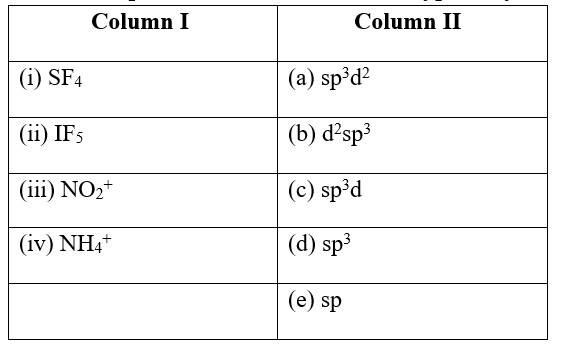Class 11th
Get insights from 8k questions on Class 11th, answered by students, alumni, and experts. You may also ask and answer any question you like about Class 11th
Follow Ask QuestionQuestions
Discussions
Active Users
Followers
New answer posted
5 months agoContributor-Level 10
This is a Assertion Type Questions as classified in NCERT Exemplar
Ans: Option (i)
Both the statements given in assertion and reason are correct and the reason given is the correct explanation for the assertion. The sodium chloride formed by the action of chlorine gas on the sodium metal has a complete octet. The valence shells of both the atoms are fulfilled, that is why attains an octet.
New answer posted
5 months agoContributor-Level 10
This is a Mathematical Reasoning Solutions Type Questions as classified in NCERT Exemplar
(i) Here, the quantifier is 'there exists'.
The negation of this statement is
There does not exist a number which is equal to its square.
(ii) Here, the quantifier is 'for every'.
The negation of the statement is
There exist a real number x, such that x is not less than x+1
(iii) Here, the quantifier is 'there exists'.
The negation of this statement is
In India, there exists a state which does not have a capital.
New answer posted
5 months agoContributor-Level 10
This is a Matching Type Questions as classified in NCERT Exemplar
Ans:
(i) Tetrahedral (c) sp3
(ii) Trigonal (a) sp2
(iii) Linear (b)sp
Explanation :-
(i) A tetrahedral molecule has four electron pairs and these make sigma bonds with each other. The s and p orbitals overlap with each other thus forming a sp3 hybridized molecule.
(ii) There are two possibilities for the central atom to have sp2 Either all the bonds are in place i.e, the bond pairs are all sigma bonds or pi bonds or there are only two bonds and one lone pair of electrons.
(iii) The sp hybridization involves the mixing of the val
New answer posted
5 months agoContributor-Level 10
This is a Mathematical Reasoning Solutions Type Questions as classified in NCERT Exemplar
(i) Here, 'and' is the connecting word
The component statements are–
(a) All rational numbers are real
(b) All real numbers are not complex
(ii) Here, 'or' is the connecting word
The component statements are–
(a) Square of an integer is positive
(b) Square of an integer is negative
(iii) Here, 'and' is the connecting word
The component statements are–
(a) The sand heats up quickly in the Sun
(b) The sand does not caool down fast at night
(iv) Here, 'and' is the connecting word
The component statements are–
(a) n = 2 is the root of the eq
New answer posted
5 months agoContributor-Level 10
This is a Matching Type Questions as classified in NCERT Exemplar
Ans:
(i) Hydrogen bond (d) HF
(ii) Resonance (e) O3
(iii) Ionic bond (b) LiF
(iv) Covalent solid (a) C
Explanation :-
(i) In hydrogen fluoride HF, hydrogen forms
New answer posted
5 months agoContributor-Level 10
This is a Matching Type Questions as classified in NCERT Exemplar
Ans:
(i) NO (c) 2.5
(ii) CO (d) 3.0
(iii) O22- (a) 1.5
(iv) O2
New answer posted
5 months agoContributor-Level 10
This is a Matching Type Questions as classified in NCERT Exemplar
Ans:
(i) H3O+ (e) Pyramidal
(ii) HC? CH (a) Linear
(iii) ClO2- &nb
New answer posted
5 months agoContributor-Level 10
This is a Mathematical Reasoning Solutions Type Questions as classified in NCERT Exemplar
(i) The component statements are
(a) Number 3 is prime
(b) Number 3 is odd
Here, both the statements are true.
(ii) The component statements are
(a) All integers are positive
(b) All integers are negative
Here, both the statements are false.
(iii) The component statements are
(a) 100 is divisible by 3
(b) 100 is divisible by 11
(c) 100 is divisible by 5
Here, the statements (a) and (b) are false and c) is true.
New answer posted
5 months agoContributor-Level 10
This is a Matching Type Questions as classified in NCERT Exemplar
Ans:
(i) SF4 (c) sp3d
(ii) IF5 (a) sp3d2
(iii) NO2+ (e) sp
(iv) NH4+ &nbs
New answer posted
5 months agoContributor-Level 10
This is a Mathematical Reasoning Solutions Type Questions as classified in NCERT Exemplar
(i) The negation of the first statement is 'the number x is a rational number'.
This is same as the second statement because if a number is not an irrational number then the number is a rational number.
Hence, the given statements are negations of each other.
(ii) The negation of the first statement is 'the number x is not a rational number. This means that the number x is an irrational number which is same as the second statement.
Hence, the given statements are negations of each other.
Taking an Exam? Selecting a College?
Get authentic answers from experts, students and alumni that you won't find anywhere else
Sign Up on ShikshaOn Shiksha, get access to
- 65k Colleges
- 1.2k Exams
- 679k Reviews
- 1800k Answers

